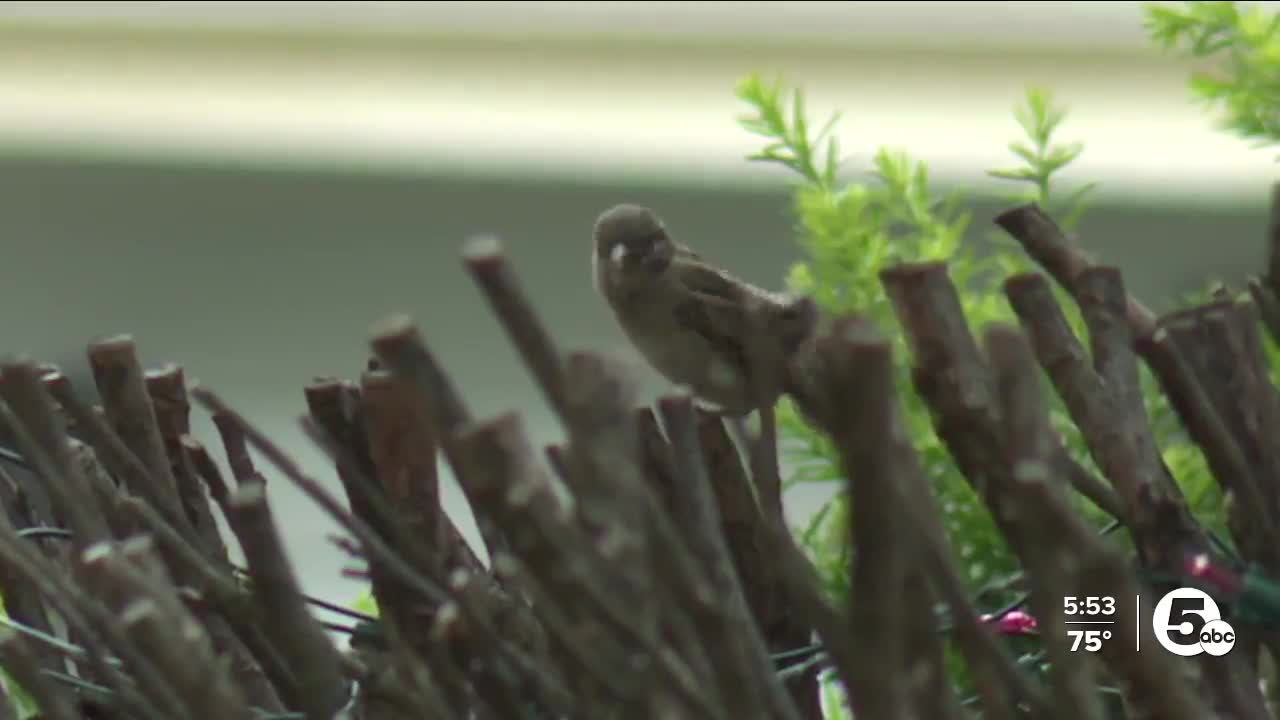Earlier this year, News 5 did astory about the popularity of bird watching in Northeast Ohio.
People from all over the world flock to Lake Erie’s shores to watch as millions of birds fly north to their summer breeding grounds.
But what goes up, must come down, and the fall bird migration is just as spectacular.
However, there are obstacles.
So, News 5 returned, along with the birds, to find out what was happening and the help they found here.
Northeast Ohio is home to many fabulous fall traditions: from apple picking, to harvest fests, to football. But there's another annual autumnal event that may fly under the radar, although shows up on the radar!
“Yes, they're migrating birds, that’s right,” exclaimed Mark Johnson, News 5 Chief Meteorologist, and birding expert, one late September night as millions of birds were seen on the Power of 5 Radar moving through our area.
More than 20 million birds can move through Ohio a night during fall bird migration, say experts. Which peaks here from September through mid-October but lingers into November.
“We send and receive migrating birds,” said Jen Brumfield, with Cleveland Metroparks, earlier this year during spring migration.
Now, those birds are flying south for winter.
Brumfield says Lake Erie acts like a big gas station where migratory birds stop to rest and refuel.
“Some will even use this as one of their last stops before they take off and make the huge flight down to Mexico or Central America,” said Brumfield. “I mean it’s just incredible!”
They migrate at night, navigating by stars and acutely attuned to weather patterns.
“Our natural world operates so differently than the human mind can comprehend it’s spectacular,” said Brumfield.
But it’s where the natural and human worlds collide that this spectacular journey can turn perilous for the birds.
“They don’t actually die from a broken neck they actually die from cranial swelling,” said Tim Jasinski, a wildlife rehabilitation specialist at the Lake Erie Nature & Science Center.
An estimated billion birds die a year from colliding with buildings, especially with glass surfaces, according to the National Audubon Society.
They see the glass as an extension of where they’re searching for food. They don’t recognize it as an impediment.
“We’re just going to medicate this guy and get him put away since we already weighed him,” said Jasinski holding a tiny warbler pulled from a paper bag.
Jasinski says they get about 3,000 birds a year. The birds are brought in by Lights Out Clevelandvolunteers, who collect the fallen flyers in the early morning hours from downtown sidewalks.
They say lights can disorient and draw birds into the buildings, causing them to strike windows or circle until they fall from exhaustion.
This is not just a Cleveland problem. Bird strikes happen everywhere, including in residential and rural areas. However, Jasinski says cities like Cleveland which are located right along a Great Lake and in the path of migratory birds, have a higher likelihood of strikes.
He also says there are more bird collisions in the fall because there are more hatchlings that are making their first big migration flight.
“On average, we get about 3,000 birds a year from downtown Cleveland, and about two-thirds of those are found dead,” said Jasinski. “About a third are alive that are collected, and we actually have a good success release rate. Every year is different, but it’s over 90% which is huge.”
He says the birds are examined, most are treated with an anti-inflammatory medicine, weighed, and then put into a dark cage to rest and heal. Smaller birds usually stay anywhere from one to three days while bigger birds will stay longer.
“Yes, it’s rewarding,” said Hannah Lesiw, a volunteer at the nature center.
Release day is one of the big reasons why Jasinski and volunteers like Lesiw do this work.
Lesiw and Jasinski gathered with several other volunteers, all standing outside the nature center behind a row of paper bags that gently hummed and scooted ever so slightly.
Inside each bag were birds that volunteers had rescued from city sidewalks after window strikes, brought to the nature center for rehabilitation, nursed back to health again, and were now ready to return to the sky.
“We’re giving them a second chance,” smiled Lesiw.
It is a special moment where you can feel the fragility of life take flight.
“We’ve lost 25% of our songbird population since the ’70s,” said Jasinski. “It’s gone, it’s not coming back. They’re really fighting the fight to survive.”
They need people to be on their side.
Jasinski and Brumfield both recommend keeping your lights low or off, when safe to do so, at night during times of bird migration.
Lights Out Cleveland also encourages buildings to enroll in its programto pledge to dim lights downtown during migration. You can see the buildings that are taking part.
There is also bird-safe glass that can help reduce and prevent bird strikes. It disrupts the plane of sight so the birds can recognize that the glass is an impediment to their foraging.
Brumfield also recommends finding a corner of your yard to plant native trees, bushes, and flowers to support the habitat that’s been lost.
“That can go a long way in bird preservation,” said Brumfield.
Jasinski says they’ve partnered with a Pennsylvania lab, thePowdermill Avian Research Center, to tag and track some of the birds they rehabilitate and release in Northeast Ohio, to see how they fair afterward.
Jasinski says the lab plans to take a deep dive into the data this winter, but early data suggests some of their birds have gone on to make multiple migrations.
Both the Lake Erie Nature & Science Center and Lights Our Cleveland need volunteers.




